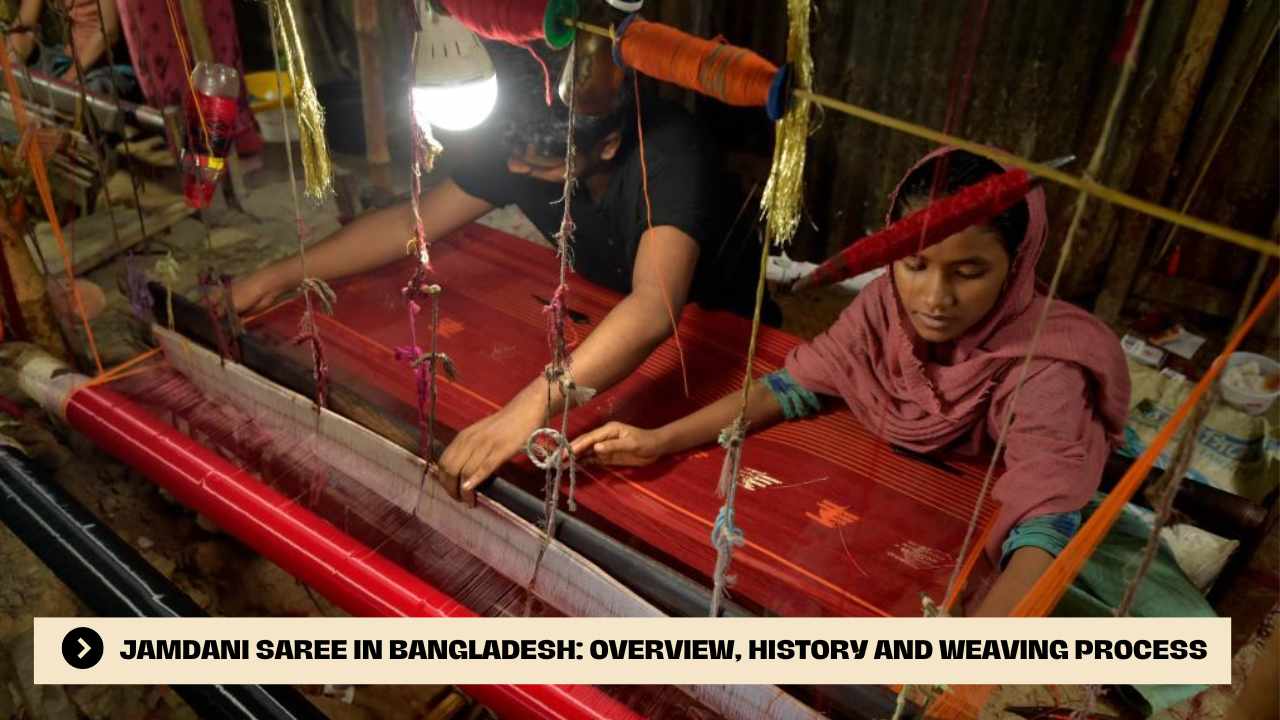Jamdani Saree is a traditional saree in Bangladesh that has a lot of popularity. Jamdani saree in Bangladesh has a long cultural heritage and has been worn longer. Jamdani saree has been made for generations in Bangladesh’s Dhaka District. Imperial warrants issued by Mughal monarchs supported the traditional jamdani manufacture.
Due to colonial import regulations that favored industrially produced textiles, the Bengali jamdani as well as muslin industries saw a fast fall during British colonization. In this article, I’m going to explore the history of the Bangladeshi jamdani saree. I’ll also discuss the manufacturing process of this popular traditional saree. So, let’s get started.
What is Jamdani Saree
Jamdani saree is a traditional handwoven cotton or silk saree produced in the Bengal area, which includes portions of Bangladesh and India. This saree is renowned for its elaborate patterns that are woven using a supplemental weft method onto the cloth. All these features give this saree a distinct texture and a delicate, translucent look.
The Persian terms “jam” and “Dani,” which both mean “vase” in English, are the roots of the phrase “jamdani.” It alludes to the floral themes that are frequently used in the saree design. Creating a design by hand is a labor-intensive and sophisticated step in the weaving of jamdani sarees and then carefully weaving it into the fabric using a small shuttle.
Jamdani sarees are often considered to be a symbol of elegance and luxury. These Sarees are worn for special occasions such as weddings and festivals. They come in a range of colors and designs, with some featuring intricate patterns. Due to their beauty and intricate craftsmanship, jamdani sarees are highly valued and prized by collectors and connoisseurs of traditional textiles.
The History of Jamdani Saree in Bangladesh
Jamdani saree is a traditional saree in Bangladesh that has an extensive and rich history. This saree is considered to be an integral part of our cultural heritage. The Jamdani saree’s beginnings can be found in the Mughal era when it was made for the Bengali royal court.
The Bengali nobility and affluent merchants became fans of the Jamdani saree throughout the 18th and 19th centuries, hiring weavers to produce elaborate patterns for their own use. Generations of weavers refined their trade and created new methods and designs, passing along the art of weaving Jamdani.
The development of machine-made textiles as well as competition from other weaving techniques, however, led to a fall in the popularity of Jamdani weaving in the 20th century. Nevertheless, attempts were undertaken to resuscitate the art form in the 1970s, and as a result, it is now acknowledged as a distinctive and highly prized component of Bangladesh’s cultural legacy.
Jamdani sarees are distinguished by their elaborate patterns and use of premium cotton and silk textiles. Flowers, paisleys, as well as geometric patterns are some of the traditional themes that are expertly woven into textiles. The Jamdani weavers are also supported by the Bangladeshi government, which helps to maintain the legacy of this ancient art.
Jamdani Saree Waving Process
Jamdani saree is produced with entirely handwoven processes that make it relatively expensive. Two weavers are needed to weave a Jamdani, one is the master craftsman and the other one is the helper. The first thing artisans do to weave jamdani rows is to collect yarn of different colors. Basically, they choose the yarn color according to the customer’s demand.
During the manufacture of Jamdani sarees, many thread kinds are employed. The yarn is finer and the work is smoother with a higher thread count. Because the pattern yarn is weaved more often to make it smooth as well as transparent, it thickens the design more than the yarn that adds texture.
The manufacturing facilities employ a variety of regional and indigenous tools, such as bamboo. Jamdani designs are woven through two cylindrical bamboo sticks. By gently tugging using two needles at the necessary locations, the colorful threads are maintained between the lines at the designated locations.
The side thread, known as “maku,” is then cut and passed from one weaver to the next. As soon as the sari is finished weaving, it is starched as well as wrapped in bamboo. The subsequent themes are then shown. The “kandul” fabric utilized to embroider the pattern on the Jamdani is so named. Initially, the saree’s inside and bodice are created and then “anchal’s” work begins.
Wrap Up
In conclusion, Jamdani saree is a pride of Bangladesh and a testament to the country’s rich cultural heritage. The intricate designs and patterns woven into the fabric by skilled artisans make Jamdani sarees a must-have for every Bangladeshi woman’s wardrobe.
Despite facing competition from cheaper mass-produced alternatives, Jamdani sarees have managed to hold their own and retain their popularity. With government support and efforts to promote the craft, Jamdani sarees are poised to continue thriving and playing a significant role in the country’s economy and cultural identity.

